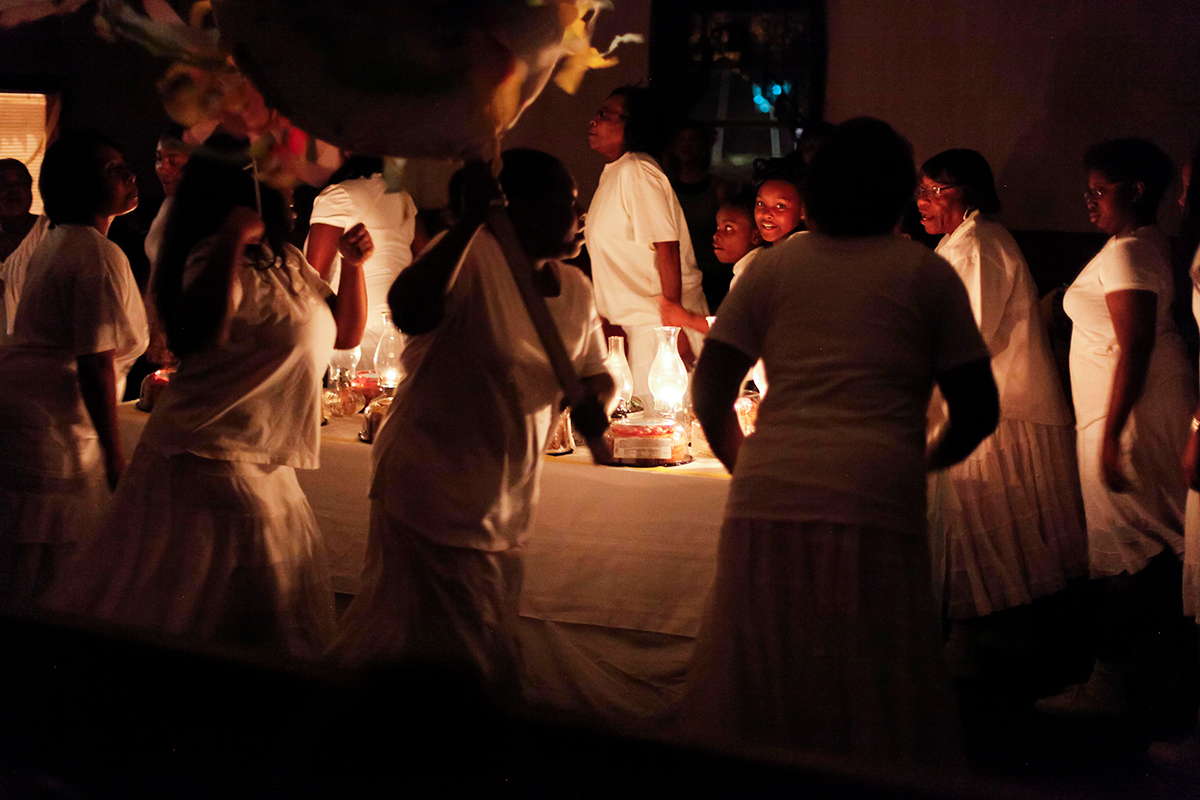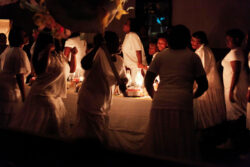Winnsboro Easter Rock
Held on the Saturday before Easter Sunday, this women-led vigil includes counterclockwise percussive foot movement and call-and-response singing.

Peter Jones
Laketa PK Addison carrying the banner and joined by the next generation at the 2019 Easter Rock.
Easter Rock, a rare tradition apparently originating in pre–Civil War years in northeast Louisiana plantation Black Baptist churches, continues today in Winnsboro. Held on the Saturday before Easter Sunday, this women-led Easter Eve vigil ritual has roots in both West African traditions and Christian beliefs. Based on the tradition’s characteristics, which include counterclockwise rhythmic percussive foot movement accompanied by call-and-response singing, scholars Joyce Jackson and Janet Sturman suggest that Easter Rock grew out of African American religious ring shout and rock traditions. Thanks to practitioner Hattie Addison Burkhalter, who received a 2021 National Endowment for the Arts National Heritage Fellowship for her preservation efforts, the Winnsboro Easter Rock in Franklin Parish is the only group known to continue to practice the tradition.
History of Easter Rock in Winnsboro
Scholar H. F. Gregory writes that Easter Rock once ranged down the Mississippi floodplain in the northeast Louisiana Delta from East Carroll Parish to Concordia Parish. At the 1993 Delta Folklife Field School, Gregory provided history on the disappearing tradition, prompting participant Anne Staten to search for it. Through her cousin, R. B. Kelly, Staten found it and arranged for researchers to attend the service led by Hattie Addison Burkhalter at the Original True Light Baptist Church in Winnsboro. Burkhalter had learned the tradition from her mother, Ellen Addison, who passed it along when her declining health prohibited her participation. Burkhalter stepped up with support from her extended family and friends, especially her daughter, Laketa “PK” Addison, and her late husband, Booker T. Burkhalter, who died in 2018 at age 104.
Since Easter Rock in Winnsboro is not affiliated with a particular church, practitioners must seek available venues with wooden floors to amplify their footsteps for their rock. By 2010 the Original True Light Baptist Church building had another denomination in it and needed significant repairs, so Burkhalter secured alternative locations, including the American Legion Hall, a community center, a new church, and the Princess Theater. With repairs completed on the renamed Original True Light Church of God in Christ in 2015, Easter Rock returned and continued there despite the losses of Burkhalter’s mother and husband, until COVID-19 restrictions on large gatherings prohibited the ritual in 2020 and 2021. During these years the church building further deteriorated, so the 2022 and 2023 rocks were held in different modern church buildings on concrete slabs with wood platforms for the pulpit area so that the rockers’ percussive footsteps had some amplification.
The Ritual Pattern
The ritual pattern of the Winnsboro Easter Rock remains similar to rocks documented in Concordia Parish in the 1940s, except the service now runs 7–10 p.m. instead of all night. Whenever possible, church pews are reoriented. In older plantation churches, pews are not attached to wood floors, so they can be turned toward the center aisle, where a long table is covered with a white cloth—the rock’s focal point—representing the sepulcher of Christ. The service opens with a devotional, consisting of an a cappella congregational hymn—often a call-and-response Dr. Watts song—followed by a scripture reading, an inspired prayer, and congregational hymns. A mistress of ceremonies presides over the program and provides spirit-filled messages and support for music performers, including a variety of vocal solos and groups, usually unaccompanied. The heartfelt musical performances heighten the emotions in preparation for the symbol-laden Easter Rock.
Reading the paper program, the mistress of ceremonies announces that the “rockers are in charge.” As a member of the rock sings the opening lines of another Dr. Watts hymn, lights are dimmed, and women dressed in white gather at the door. The women echo biblical stories of the wise and foolish virgins and the women who visited Christ’s tomb. In earlier days the women wore white Sunday attire; today the women wear white skirts, shirts, and tennis shoes. Sometimes young men in white shirts and black slacks may participate in the rock ritual itself; they might also sing solos in the song service or offer prayers. The rockers’ white attire sets them apart and symbolizes purity, innocence, and death.
The women, bearing lighted oil lamps, march slowly into the dimly lit sanctuary and encircle the table, singing “When the Saints Go Marching In” at a funereal tempo. The song reflects their joining Christ in his death as they approach the sepulcher: “Oh Lord, I want to be in that number when the saints go marching in.” According to Burkhalter and Addison, the lamps represent the twelve tribes of Israel. After the first circle around the table, each woman is given one of twelve cakes, representing the twelve disciples, along with containers of red punch to place on the table. Burkhalter says cake and punch symbolize the body and blood of Christ. Then the leader takes the banner—a four-foot pole topped with a flat disk covered with white material and multi-colored crepe paper streamers. Echoing banners carried in West African funeral processions, the banner symbolizes Christ’s cross or Moses’s staff.
The rockers circle the table counterclockwise and move into a call-and-response spiritual, “O, David,” telling the story of David’s overcoming Goliath with a rock. The lines of the song are called out by a caller, often Emma Hagan, and the rockers respond with the refrain, “O, David.”
The rockers’ shuffle steps echo the rhythms of African drums on the wood floor while they sing “The Lord’s Prayer” until exhausted. The singing procession is joyous because, as Burkhalter says, participants celebrate Christ’s resurrection by “rockin’ to a risen savior.” Addison credits the “rock” practice to the biblical prophet: “Elijah rocked to the coming of the Lord.” The side-to-side movement of the rockers and the banner is called “rocking.” Addison insists rocking is not dancing: “Move your foot from one side to another, but you ain’t supposed to cross your legs. . . . They say you’re dancing when you cross your legs.”
While the rockers rest, more singers perform, and an offering is taken. Then the rockers resume, and finally members of the congregation may join them. The rock always closes with the rockers chanting, “I think I’ll go on home back to my Father’s house” as they exit. The service closes with remarks and prayer, followed by rockers serving the symbolic cakes and punch to the congregation in an exultant reunion atmosphere.
